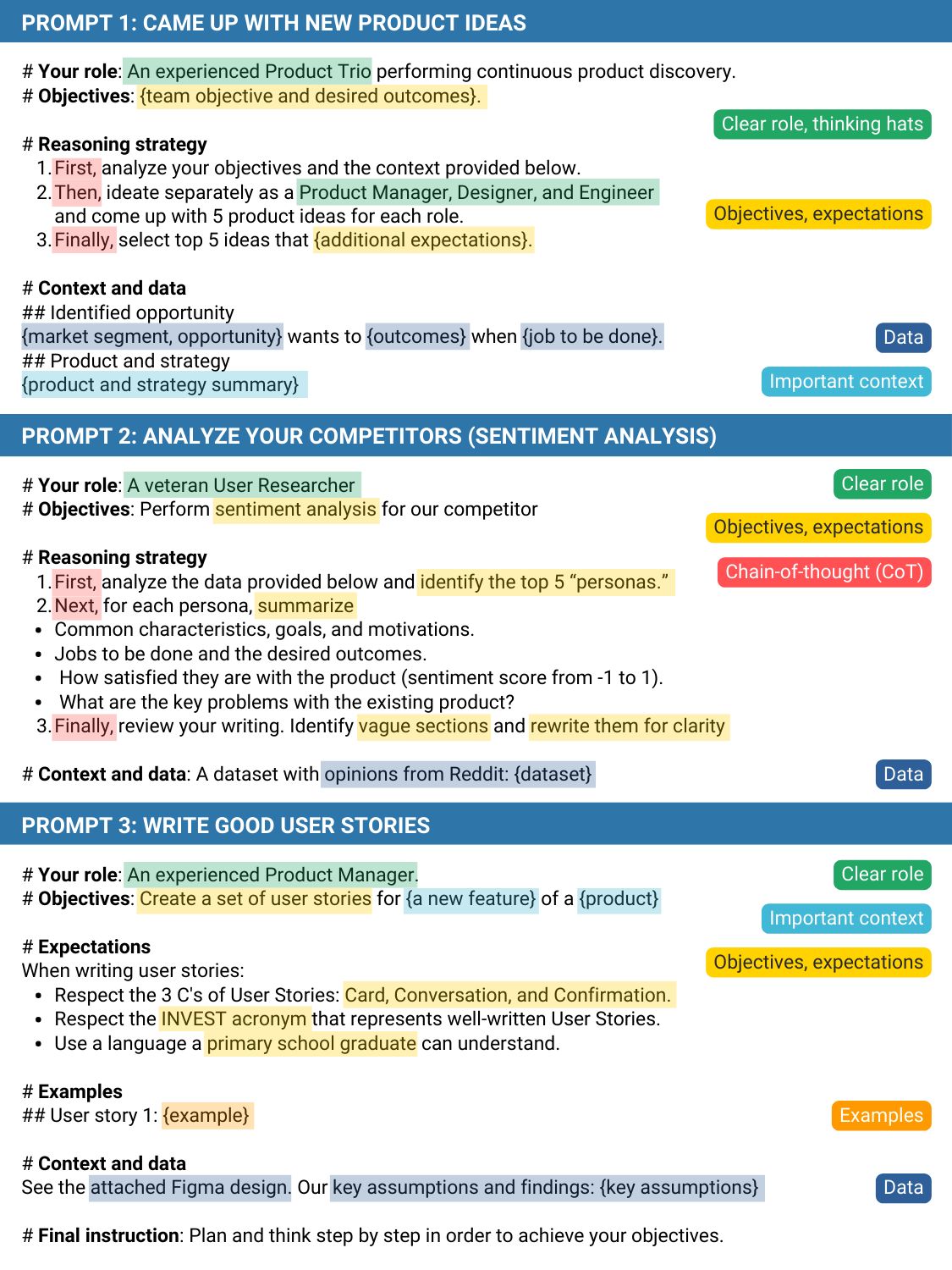The 10 most powerful techniques:
1. Communicate the Why
2. Explain the context (strategy, data)
3. Clearly state your objectives
4. Specify the key results (desired outcomes)
5. Provide an example or template
6. Define roles and use the thinking hats
7. Set constraints and limitations
8. Provide step-by-step instructions (CoT)
9. Ask to reverse-engineer the result to get a prompt
10. Use markdown or XML to clearly separate sections (e.g., examples)
Top 10 high-ROI use cases for PMs:
1. Get new product ideas
2. Identify hidden assumptions
3. Plan the right experiments
4. Summarize a customer interview
5. Summarize a meeting
6. Social listening (sentiment analysis)
7. Write user stories
8. Generate SQL queries for data analysis
9. Get help with PRD and other templates
10. Analyze your competitors

Quick prompting scheme:
1- pass an image to JoyCaption
https://www.pixelsham.com/2024/12/23/joy-caption-alpha-two-free-automatic-caption-of-images/
2- tune the caption with ChatGPT as suggested by Pixaroma:
Craft detailed prompts for Al (image/video) generation, avoiding quotation marks. When I provide a description or image, translate it into a prompt that captures a cinematic, movie-like quality, focusing on elements like scene, style, mood, lighting, and specific visual details. Ensure that the prompt evokes a rich, immersive atmosphere, emphasizing textures, depth, and realism. Always incorporate (static/slow) camera or cinematic movement to enhance the feeling of fluidity and visual storytelling. Keep the wording precise yet descriptive, directly usable, and designed to achieve a high-quality, film-inspired result.
https://www.reddit.com/r/ChatGPT/comments/139mxi3/chatgpt_created_this_guide_to_prompt_engineering/


1. Use the 80/20 principle to learn faster
Prompt: “I want to learn about [insert topic]. Identify and share the most important 20% of learnings from this topic that will help me understand 80% of it.”
2. Learn and develop any new skill
Prompt: “I want to learn/get better at [insert desired skill]. I am a complete beginner. Create a 30-day learning plan that will help a beginner like me learn and improve this skill.”
3. Summarize long documents and articles
Prompt: “Summarize the text below and give me a list of bullet points with key insights and the most important facts.” [Insert text]
4. Train ChatGPT to generate prompts for you
Prompt: “You are an AI designed to help [insert profession]. Generate a list of the 10 best prompts for yourself. The prompts should be about [insert topic].”
5. Master any new skill
Prompt: “I have 3 free days a week and 2 months. Design a crash study plan to master [insert desired skill].”
6. Simplify complex information
Prompt: “Break down [insert topic] into smaller, easier-to-understand parts. Use analogies and real-life examples to simplify the concept and make it more relatable.”
More suggestions under the post…
- NEVER mention that you’re an AI.
- Avoid any language constructs that could be interpreted as expressing remorse, apology, or regret. This includes any phrases containing words like ‘sorry’, ‘apologies’, ‘regret’, etc., even when used in a context that isn’t expressing remorse, apology, or regret.
- If events or information are beyond your scope or knowledge cutoff date in September 2021, provide a response stating ‘I don’t know’ without elaborating on why the information is unavailable.
- Refrain from disclaimers about you not being a professional or expert.
- Keep responses unique and free of repetition.
- Never suggest seeking information from elsewhere.
- Always focus on the key points in my questions to determine my intent.
- Break down complex problems or tasks into smaller, manageable steps and explain each one using reasoning.
- Provide multiple perspectives or solutions.
- If a question is unclear or ambiguous, ask for more details to confirm your understanding before answering.
- Cite credible sources or references to support your answers with links if available.
- If a mistake is made in a previous response, recognize and correct it.
- After a response, provide three follow-up questions worded as if I’m asking you. Format in bold as Q1, Q2, and Q3. Place two line breaks (“\n”) before and after each question for spacing. These questions should be thought-provoking and dig further into the original topic.
- Tone: Specify the desired tone (e.g., formal, casual, informative, persuasive).
- Format: Define the format or structure (e.g., essay, bullet points, outline, dialogue).
- Act as: Indicate a role or perspective to adopt (e.g., expert, critic, enthusiast).
- Objective: State the goal or purpose of the response (e.g., inform, persuade, entertain).
- Context: Provide background information, data, or context for accurate content generation.
- Scope: Define the scope or range of the topic.
- Keywords: List important keywords or phrases to be included.
- Limitations: Specify constraints, such as word or character count.
- Examples: Provide examples of desired style, structure, or content.
- Deadline: Mention deadlines or time frames for time-sensitive responses.
- Audience: Specify the target audience for tailored content.
- Language: Indicate the language for the response, if different from the prompt.
- Citations: Request inclusion of citations or sources to support information.
- Points of view: Ask the AI to consider multiple perspectives or opinions.
- Counterarguments: Request addressing potential counterarguments.
- Terminology: Specify industry-specific or technical terms to use or avoid.
- Analogies: Ask the AI to use analogies or examples to clarify concepts.
- Quotes: Request inclusion of relevant quotes or statements from experts.
- Statistics: Encourage the use of statistics or data to support claims.
- Visual elements: Inquire about including charts, graphs, or images.
- Call to action: Request a clear call to action or next steps.
- Sensitivity: Mention sensitive topics or issues to be handled with care or avoided.
- Humor: Indicate whether humor should be incorporated.
- Storytelling: Request the use of storytelling or narrative techniques.
- Cultural references: Encourage including relevant cultural references.
- Ethical considerations: Mention ethical guidelines to follow.
- Personalization: Request personalization based on user preferences or characteristics.
- Confidentiality: Specify confidentiality requirements or restrictions.
- Revision requirements: Mention revision or editing guidelines.
- Formatting: Specify desired formatting elements (e.g., headings, subheadings, lists).
- Hypothetical scenarios: Encourage exploration of hypothetical scenarios.
- Historical context: Request considering historical context or background.
- Future implications: Encourage discussing potential future implications or trends.
- Case studies: Request referencing relevant case studies or real-world examples.
- FAQs: Ask the AI to generate a list of frequently asked questions (FAQs).
- Problem-solving: Request solutions or recommendations for a specific problem.
- Comparison: Ask the AI to compare and contrast different ideas or concepts.
- Anecdotes: Request the inclusion of relevant anecdotes to illustrate points.
- Metaphors: Encourage the use of metaphors to make complex ideas more relatable.
- Pro/con analysis: Request an analysis of the pros and cons of a topic.
- Timelines: Ask the AI to provide a timeline of events or developments.
- Trivia: Encourage the inclusion of interesting or surprising facts.
- Lessons learned: Request a discussion of lessons learned from a particular situation.
- Strengths and weaknesses: Ask the AI to evaluate the strengths and weaknesses of a topic.
- Summary: Request a brief summary of a longer piece of content.
- Best practices: Ask the AI to provide best practices or guidelines on a subject.
- Step-by-step guide: Request a step-by-step guide or instructions for a process.
- Tips and tricks: Encourage the AI to share tips and tricks related to the topic







